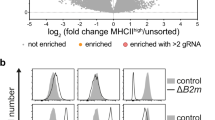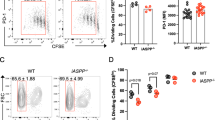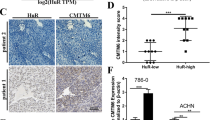Abstract
The transporter associated with antigen processing (TAP) 1 is required for the major histocompatibility complex (MHC) class I antigen presentation pathway, which plays a key role in host tumor surveillance. Since more than 50% of tumors have a dysfunctional p53, evasion of tumor surveillance by tumor cells may be linked to loss of p53 function. Here we found that TAP1 is strongly induced by p53 and DNA-damaging agents through a p53-responsive element. We also found that p73, which is homologous to p53, is capable of inducing TAP1 and cooperates with p53 to activate TAP1. Furthermore, we found that by inducing TAP1, p53 enhances the transport of MHC class I peptides and expression of surface MHC-peptide complexes, and cooperates with interferon γ to activate the MHC class I pathway. These results suggest that tumor surveillance may be a mechanism by which p53 and/or p73 function as tumor suppressors.
This is a preview of subscription content, access via your institution
Access options
Subscribe to this journal
Receive 50 print issues and online access
$259.00 per year
only $5.18 per issue
Buy this article
- Purchase on Springer Link
- Instant access to full article PDF
Prices may be subject to local taxes which are calculated during checkout








Similar content being viewed by others
References
Almog N and Rotter V. . 1998 Biochim. Biophys. Acta. 1378: R43–R54.
Alpan RS, Zhang M and Pardee AB. . 1996 Cancer Res. 56: 4358–4361.
Amiot L, Onno M, Lamy T, Dauriac C, Le Prise PY, Fauchet R and Drenou B. . 1998 Br. J. Haematol. 100: 655–663.
Beck S, Kelly A, Radley E, Khurshid F, Alderton RP and Trowsdale J. . 1992 J. Mol. Biol. 228: 433–441.
Chen HL, Gabrilovich D, Tampe R, Girgis KR, Nadaf S and Carbone DP. . 1996a Nat. Genet. 13: 210–213.
Chen X. . 1991 Mol. Med. Today 5:, 387–392.
Chen X, Bargonetti J and Prives C. . 1995 Cancer Res. 55: 4257–4263.
Chen X, Farmer G, Zhu H, Prywes R and Prives C. . 1993 Genes Dev. 7: 1837–1849.
Chen X, Ko LJ, Jayaraman L and Prives C. . 1996b Genes Dev. 10: 2438–2451.
Cheng NC, Chan AJ, Beitsma MM, Speleman F, Westerveld A and Versteeg R. . 1996 Hum. Mol. Genet. 5: 309–317.
Cromme FV, Airey J, Heemels MT, Ploegh HL, Keating PJ, Stern PL, Meijer CJ and Walboomers JM. . 1994 J. Exp. Med. 179: 335–340.
D'Urso CM, Wang ZG, Cao Y, Tatake R, Zeff RA and Ferrone S. . 1991 J. Clin. Invest. 87: 284–292.
Deiss LP and Kimchi A. . 1991 Science 252: 117–120.
el-Deiry WS, Kern SE, Pietenpol JA, Kinzler KW and Vogelstein B. . 1992 Nat. Genet. 1: 45–49.
el-Deiry WS, Tokino T, Velculescu VE, Levy DB, Parsons R, Trent JM, Lin D, Mercer WE, Kinzler KW and Vogelstein B. . 1993 Cell 75: 817–825.
Gobin SJ, Peijnenburg A, Keijsers V and van den Elsen PJ. . 1997 Immunity. 6: 601–611.
Hermeking H, Lengauer C, Polyak K, He TC, Zhang L, Thiagalingam S, Kinzler KW and Vogelstein B. . 1997 Mol. Cell. 1: 3–11.
Hollstein M, Sidransky D, Vogelstein B and Harris CC. . 1991 Science 253: 49–53.
Johansen FE and Prywes R. . 1994 Mol. Cell. Biol. 14: 5920–5928.
Johnsen A, France J, Sy MS and Harding CV. . 1998 Cancer Res. 58: 3660–3667.
Jost CA, Marin MC and Kaelin Jr WG. . 1997 Nature 389: 191–194.
Kaghad M, Bonnet H, Yang A, Creancier L, Biscan JC, Valent A, Minty A, Chalon P, Lelias JM, Dumont X, Ferrara P, McKeon F and Caput D. . 1997 Cell 90: 809–819.
Kaklamanis L, Leek R, Koukourakis M, Gatter KC and Harris AL. . 1995 Cancer Res. 55: 5191–5194.
Kaplan DH, Shankaran V, Dighe AS, Stockert E, Aguet M, Old LJ and Schreiber RD. . 1998 Proc. Natl. Acad. Sci. USA 95: 7556–7561.
Khanna R, Busson P, Burrows SR, Raffoux C, Moss DJ, Nicholls JM and Cooper L. . 1998 Cancer Res. 58: 310–314.
Ko LJ and Prives C. . 1996 Genes Dev. 10: 1054–1072.
Levine AJ. . 1997 Cell 88: 323–331.
Ma W, Lehner PJ, Cresswell P, Pober JS and Johnson DR. . 1997 J. Biol. Chem. 272: 16585–16590.
Martin BK, Chin KC, Olsen JC, Skinner CA, Dey A, Ozato K and Ting JP. . 1997 Immunity 6: 591–600.
McMichael A. . 1998 Cell 93: 673–676.
Meyer TH, van Endert PM, Uebel S, Ehring B and Tampe R. . 1994 FEBS Lett. 351: 443–447.
Miyashita T, Krajewski S, Krajewska M, Wang HG, Lin HK, Liebermann DA, Hoffman B and Reed JC. . 1994 Oncogene 9: 1799–1805.
Munger K, Phelps WC, Bubb V, Howley PM and Schlegel R. . 1989 J. Virol. 63: 4417–4421.
Nelson WG and Kastan MB. . 1994 Mol. Cell. Biol. 14: 1815–1823.
Old LJ and Chen YT. . 1998 J. Exp. Med. 187: 1163–1167.
Pamer E and Cresswell P. . 1998 Annu. Rev. Immunol. 16: 323–358.
Ploegh HL. . 1998 Science 280: 248–253.
Polyak K, Xia Y, Zweier JL, Kinzler KW and Vogelstein B. . 1997 Nature 389: 300–305.
Proffitt JA and Blair GE. . 1997 FEBS Lett. 400: 141–144.
Restifo NP, Esquivel F, Kawakami Y, Yewdell JW, Mule JJ, Rosenberg SA and Bennink JR. . 1993a J. Exp. Med. 177: 265–272.
Restifo NP, Kawakami Y, Marincola F, Shamamian P, Taggarse A, Esquivel F and Rosenberg SA. . 1993b J. Immunother. 14: 182–190.
Stark GR, Kerr IM, Williams BR, Silverman RH and Schreiber RD. . 1998 Annu. Rev. Biochem. 67: 227–264.
Vitale M, Rezzani R, Rodella L, Zauli G, Grigolato P, Cadei M, Hicklin DJ and Ferrone S. . 1998 Cancer Res. 58: 737–742.
Waldman T, Lengauer C, Kinzler KW and Vogelstein B. . 1996 Nature 381: 713–716.
Wang Z, Seliger B, Mike N, Momburg F, Knuth A and Ferrone S. . 1998 Cancer Res. 58: 2149–2157.
Zhu J, Jiang J, Zhou W and Chen X. . 1998a Cancer Res. 58: 5061–5065.
Zhu J, Zhou W, Jiang J and Chen X. . 1998b J. Biol. Chem. 273: 13030–13036.
Acknowledgements
We are grateful to Drs R Markowitz, W Dynan, D Munn, M Iwashima and A Mellor for their critical reading of this manuscript and/or suggestions. We would like to thank H Ploegh (MIT, MA) for human TAP1 cDNA, J Trowsdale (University of Cambridge, UK) for TAP1 genomic DNA, B Seliger (Johannes Gutenberg-Universität, Germany) for anti-TAP1 antibody, D Dransfield (Medical College of Georgia, GA, USA) for HCT116 and LST174T cell lines, B Vogelstein (Johns Hopkins University, MD, USA) for 8OS14 cell line, and A Mellor (Medical College of Georgia, GA, USA) for H2-Kb cDNA. This work is supported in part by grants from the National Institute of Health (CA76069 and CA81237) and DOD Army Breast Cancer Program (DAMD17-97-1-7019).
Author information
Authors and Affiliations
Rights and permissions
About this article
Cite this article
Zhu, K., Wang, J., Zhu, J. et al. p53 induces TAP1 and enhances the transport of MHC class I peptides. Oncogene 18, 7740–7747 (1999). https://doi.org/10.1038/sj.onc.1203235
Received:
Revised:
Accepted:
Published:
Issue Date:
DOI: https://doi.org/10.1038/sj.onc.1203235
Keywords
This article is cited by
-
Translating p53-based therapies for cancer into the clinic
Nature Reviews Cancer (2024)
-
MHC class I dysfunction of glioma stem cells escapes from CTL-mediated immune response via activation of Wnt/β-catenin signaling pathway
Oncogene (2020)
-
RETRACTED ARTICLE: Tumor necrosis factor overcomes immune evasion in p53-mutant medulloblastoma
Nature Neuroscience (2020)
-
IFN-gamma-induced PD-L1 expression in melanoma depends on p53 expression
Journal of Experimental & Clinical Cancer Research (2019)
-
p53 increases MHC class I expression by upregulating the endoplasmic reticulum aminopeptidase ERAP1
Nature Communications (2013)



